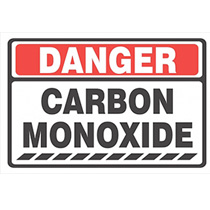
More Articles

Name:
Carbon Monoxide
Abbreviation:
CO
General Description:
It is a colorless, odorless gas. It is toxic to humans. It can be deadly at sufficient quantities. It is produced by incomplete combustion of carbon-based fuels. This includes machinery powered by internal combustion engines.
Odor
CO is an odorless gas.
Compared to Air:
CO is slightly lighter than air.
Combustible:
CO is combustible and burns with a blue or purple flame.
Exposure Limits:
The World Health Organization (WHO) has issued guidelines of airborne levels of CO. Over an 8-hour day the limit is 9 parts per million (ppm). The limits for one hour, 30 minutes and 15 minutes are 26 ppm, 52 ppm, and 87 ppm respectively. Below these levels for the specified period of time is expected to prevent carboxyhemoglobin (COHb) from rising above 2.5%. There are other limits set by other agencies, but these are quite workable.
What the heck is COHb and what does it do?
Normally oxygen combines with hemoglobin to deliver oxygen to areas of the body where it is needed. In the presence of carbon monoxide, the CO essentially replaces oxygen in combining with hemoglobin thereby causing gradual suffocation. Carboxyhemoglobin replaces oxyhemoglobin.
Steve's IAQ Recommendations:
The WHO guidelines are adequate, but anytime I get CO levels above 4 ppm, I consider that the source should be determined as possible and dealt with. Essentially 4 ppm is the action level.

Examples:
Gas heaters inside a house should frequently be checked, particularly at the beginning of the heating season for cracked heat exchangers that can cause release the of CO. Keep in mind that “Oh! You have a cracked heat exchanger so need a new heater or (expensive) repair,” is a scam that is often used by unethical companies. So have them show the crack and satisfy you that it is really there. Avoid having water heaters inside the house. An enclosure outside the outside the house and properly vented is much safer. Never use a charcoal grill inside the house either to cook and especially for heat.
Physical Effects (High Concentrations):
(Progressively) Headache, fatigue, shortness of breath, nausea, dizziness, mental confusion, vomiting, loss of muscle coordination, loss of consciousness, death.
Physical Effects (Lower Levels):
Lower level exposure to CO can easily be misdiagnosed. It can be mistaken for a gastrointestinal or pulmonary infection, chronic fatigue or reaction to heat exposure. In an office environment, if a number of occupants are suffering from similar symptoms and feel better when out of the office, carbon monoxide exposure should be considered.
How Produced:
Incomplete combustion, burning of carbon-based fuels, volcanic eruptions.






